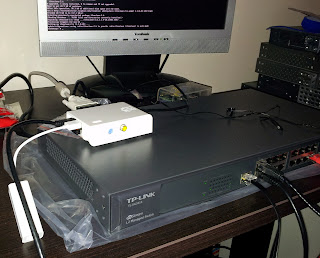Adding 802.1Q Trunking to Debian GNU/Linux
Here's a quick
guide to setting up 802.1Q trunking for VLANs on a Debian GNU/Linux box
connected to one or more Cisco Catalyst switches, which could then be
used as a cheap router replacement.
switch1#sh vl br
VLAN Name Status Ports
---- ---------------- --------- ---------------------------
1 default active Fa0/1, Fa0/2, Fa0/3, Fa0/4,
Fa0/5, Fa0/8, Fa0/9, Fa0/12,
Fa0/13, Fa0/14, Fa0/15, Fa0/16,
Fa0/17, Fa0/18, Fa0/19, Fa0/20,
Fa0/21, Fa0/22, Fa0/23, Gi0/1,
Gi0/2
2 testing active Fa0/6, Fa0/7, Fa0/10, Fa0/11
switch1#sh int status
Port Name Status Vlan Duplex Speed Type
------- ----- ------------ -------- ------ ------- ----
Fa0/6 notconnect 2 Auto Auto 100BaseTX/FX
Fa0/7 connected 2 A-Full A-100 100BaseTX/FX
Fa0/10 notconnect 2 Auto Auto 100BaseTX/FX
Fa0/11 notconnect 2 Auto Auto 100BaseTX/FX
Fa0/24 connected trunk A-Full A-100 100BaseTX/FX
Configuration
on the Debian box:
Add
8021q to
/etc/modules
so 802.1Q
support is enabled at startup. To install it immediately:
#
modprobe 8021q
Use
vconfig
to add the VLANs to the interface you'll be using (if vconfig is
missing, run apt-get install vlan):
#
vconfig add eth0 2
(In
the above, eth0 is the physical interface and 2 is the ID of the
VLAN)
Give
the interface an IP. Choose an address
in the range you've set aside for that particular VLAN. In this
example, VLAN 2 is using 192.168.2.0/24.
#
ifconfig eth0.2 192.168.2.201 netmask 255.255.255.0
Edit
/etc/network/interfaces
to
assign permanent settings to your new interface(s) – the virtual
interface takes its name from the interface to which it is attached
plus the VLAN ID: for example, setting up VLAN
2
via interface eth0
results in an interface called eth0.2.
auto
eth0.2
iface
eth0.2 inet static
address
192.168.2.201
netmask
255.255.255.0
vlan_raw_device
eth0
Whichever
method is used, check the VLAN interface has come up correctly:
#
ifconfig eth0.2
eth0.2
Link encap:Ethernet HWaddr 00:c0:9f:9a:45:dc
inet
addr:192.168.2.202 Bcast:192.168.2.255 Mask:255.255.255.0
inet6
addr: fe80::2c0:9fff:fe9a:45dc/64 Scope:Link
UP
BROADCAST RUNNING MULTICAST MTU:1500 Metric:1
RX
packets:278 errors:0 dropped:0 overruns:0 frame:0
TX
packets:293 errors:0 dropped:0 overruns:0 carrier:0
collisions:0
txqueuelen:0
RX
bytes:29924 (29.2 KiB) TX bytes:34873 (34.0 KiB)
It's
also important to make sure the trunking interface (eth0 in the
above) has no IP assigned (or at least not one in any of the VLANs
you've configured). To clear any address currently assigned, enter:
#
ifconfig eth0 0.0.0.0
Configuration
on the switch (C3500XL in this case):
First
up, create at least one VLAN apart from the default VLAN1:
(NB:
The process for creating VLANs differs depending on the model of
switch used)
#vlan
database
(vlan)#vlan
2
(vlan)#vlan
2 name testing
Set
the switch to be a VTP server and name the VTP domain:
(vlan)#vtp
server
(vlan)#vtp
domain testing
Then,
enable trunking on a port (24 in this example) and give all VLANs
access to it:
(config)#
interface fa0/24
(config)#
switchport trunk encapsulation dot1q
(config)#
switchport mode trunk
(config)#
switchport trunk access vlan all
Check
the port's configuration (important sections in bold):
#sh
int fa0/24 switchport
Name:
Fa0/24
Switchport:
Enabled
Administrative
mode: trunk
Operational
Mode: trunk
Administrative
Trunking Encapsulation: dot1q
Operational
Trunking Encapsulation: dot1q
Negotiation
of Trunking: Disabled
Access
Mode VLAN: 0 ((Inactive))
Trunking
Native Mode VLAN: 1 (default)
Trunking
VLANs Enabled: ALL
Trunking
VLANs Active: 1,2
Pruning
VLANs Enabled: 2-1001
Priority
for untagged frames: 0
Override
vlan tag priority: FALSE
Voice
VLAN: none
Appliance
trust: none
Add
some ports to the VLAN (repeat the below for each port, or use (for example) int
range fa0/7 – 10 if supported by your switch:
(config)#
int fa0/7
(config-int)#
switchport access vlan 2
Check
that the ports have been assigned correctly:
VLAN Name Status Ports
---- ---------------- --------- ---------------------------
1 default active Fa0/1, Fa0/2, Fa0/3, Fa0/4,
Fa0/5, Fa0/8, Fa0/9, Fa0/12,
Fa0/13, Fa0/14, Fa0/15, Fa0/16,
Fa0/17, Fa0/18, Fa0/19, Fa0/20,
Fa0/21, Fa0/22, Fa0/23, Gi0/1,
Gi0/2
2 testing active Fa0/6, Fa0/7, Fa0/10, Fa0/11
Connect
the trunking port to the PC and hook up another device to one of the
VLAN 2 ports.
On
the switch, check the status of the interfaces (cropped; only
relevant interfaces shown):
Port Name Status Vlan Duplex Speed Type
------- ----- ------------ -------- ------ ------- ----
Fa0/6 notconnect 2 Auto Auto 100BaseTX/FX
Fa0/7 connected 2 A-Full A-100 100BaseTX/FX
Fa0/10 notconnect 2 Auto Auto 100BaseTX/FX
Fa0/11 notconnect 2 Auto Auto 100BaseTX/FX
Fa0/24 connected trunk A-Full A-100 100BaseTX/FX
They
should be now able to ping each other, as below:
From
the Client PC (connected to port 7):
#
ping 192.168.2.202
PING
192.168.2.202 (192.168.2.202) 56(84) bytes of data.
64
bytes from 192.168.2.202: icmp_req=1 ttl=64 time=0.244 ms
64
bytes from 192.168.2.202: icmp_req=2 ttl=64 time=0.264 ms
64
bytes from 192.168.2.202: icmp_req=3 ttl=64 time=0.251 ms
64
bytes from 192.168.2.202: icmp_req=4 ttl=64 time=0.238 ms
64
bytes from 192.168.2.202: icmp_req=5 ttl=64 time=0.244 ms
From
the Trunking PC (connected to port 24):
#
ping 192.168.2.50
PING
192.168.2.50 (192.168.2.50) 56(84) bytes of data.
64
bytes from 192.168.2.50: icmp_seq=1 ttl=64 time=0.153 ms
64
bytes from 192.168.2.50: icmp_seq=2 ttl=64 time=0.196 ms
64
bytes from 192.168.2.50: icmp_seq=3 ttl=64 time=0.192 ms

Comments
Post a Comment